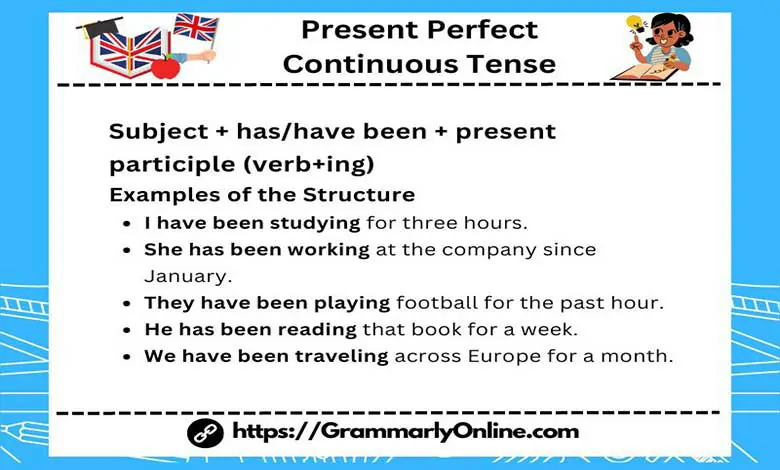Present Perfect Continuous Tense: Rules & Examples

The Present Perfect Continuous Tense is a fundamental aspect of English grammar that conveys ongoing actions or situations that began in the past and are still continuing or have recently stopped. This tense is often used to emphasize the duration or continuous nature of an action. In this comprehensive guide, we will delve into the rules governing the Present Perfect Continuous Tense, provide detailed examples, and explore its practical applications in various contexts.
Understanding the Present Perfect Continuous Tense
The Present Perfect Continuous Tense combines aspects of both the Present Perfect and Present Continuous Tenses. It is used to describe actions that began in the past and have been continuing up to the present moment or actions that have recently stopped but have relevance to the present. This tense is formed using the structure:
Subject + has/have been + present participle (verb+ing)
Examples of the Structure
- I have been studying for three hours.
- She has been working at the company since January.
- They have been playing football for the past hour.
Rules of the Present Perfect Continuous Tense
1. Formation
To form the Present Perfect Continuous Tense, adhere to the following structure:
- Subject + has/have been + verb+ing
Examples:
- He has been reading that book for a week.
- We have been traveling across Europe for a month.
2. Use of “Since” and “For”
The Present Perfect Continuous Tense frequently uses the words “since” and “for” to indicate the starting point or duration of the action.
- “Since” is used to specify the starting point of the action.
- She has been learning Spanish since 2015.
- “For” is used to indicate the duration of the action.
- They have been renovating the house for six months.
3. Emphasis on Duration
This tense is particularly useful when we want to emphasize the duration of an activity that is still in progress or has recently stopped.
- He has been working on the project for several weeks, showing the ongoing nature of his effort.
- We have been waiting for the bus since 3 PM, highlighting the continuous waiting period.
4. Negative Form
To form the negative, insert “not” after “been” in the structure:
- Subject + has/have not been + verb+ing
Examples:
- I have not been feeling well lately.
- She has not been attending the classes regularly.
5. Question Form
To ask questions in the Present Perfect Continuous Tense, invert the position of “has” or “have” and the subject:
- Has/Have + subject + been + verb+ing?
Examples:
- Have you been working on this report?
- Has he been studying for the exams?
Practical Applications and Examples
1. Daily Life and Routine
The Present Perfect Continuous Tense is frequently used to describe ongoing actions and routines in daily life.
- I have been cooking dinner since 5 PM.
- She has been exercising regularly to stay fit.
2. Work and Study
In professional and academic settings, this tense helps to discuss ongoing projects or studies.
- They have been researching for their thesis for months.
- We have been preparing the presentation for the upcoming meeting.
3. Recent Activities
It also helps to convey actions that have recently stopped but are still relevant to the present moment.
- He has been running a fever, so he is taking it easy today.
- She has been working late at the office, which is why she looks tired.
4. Highlighting Efforts and Progress
The Present Perfect Continuous Tense is ideal for emphasizing the effort or progress made in an activity.
- They have been trying to fix the car all day.
- We have been developing new software features to enhance performance.
Common Mistakes and How to Avoid Them
1. Confusing with Simple Present Perfect Tense
A common error is confusing the Present Perfect Continuous with the Present Perfect Tense. Remember that the Present Perfect Continuous focuses on the duration or ongoing nature, while the Present Perfect Tense emphasizes the completion of an action.
- Incorrect: I have studied for three hours.
- Correct: I have been studying for three hours.
2. Using Incorrect Verb Forms
Ensure that you use the present participle (verb+ing) form correctly to avoid grammatical errors.
- Incorrect: She has been study for her exams.
- Correct: She has been studying for her exams.
3. Overusing “Since” and “For”
While “since” and “for” are integral, their misuse can lead to confusion. Use “since” to refer to a point in time and “for” to indicate a duration.
- Incorrect: He has been working here since two years.
- Correct: He has been working here for two years.
Conclusion
The Present Perfect Continuous Tense is an essential part of English grammar, offering nuanced ways to discuss ongoing or recently completed actions with a focus on their duration. By mastering its rules and understanding its practical applications, one can enhance both written and spoken English proficiency. Use this tense effectively to communicate actions that span from the past to the present, highlighting continuous efforts and ongoing situations.

